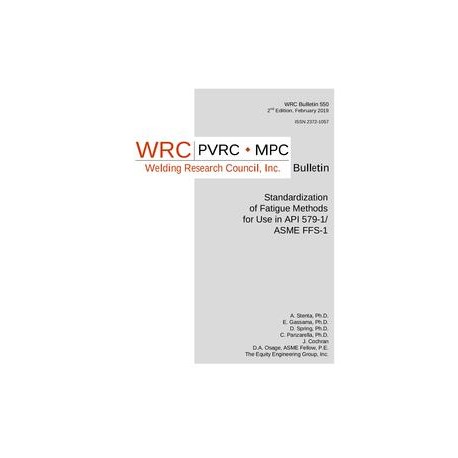Cart 0 Product Products (empty)
No products
To be determined Shipping
$0.00 Total
Product successfully added to your shopping cart
Quantity
Total
There are 0 items in your cart. There is 1 item in your cart.
Total products
Total shipping To be determined
Total
New Reduced price!  View larger
View larger
 View larger
View larger WRC 550
M00000466
New product
WRC 550 Standardization of Fatigue Methods for Use in API 579-1/ASME FFS-1
Bulletin / Circular by Welding Research Council, 2019
A. Stenta, Ph.D. E. Gassama, Ph.D. D. Spring, Ph.D. C. Panzarella, Ph.D. J. Cochran D.A. Osage, ASME Fellow, P.E.
In stock
More info
Full Description
The third edition of API 579-1/ASME FFS-1 Fitness-For-Service will include a new Part 14 covering fatigue assessment procedures for in-service components, primarily for low-cycle fatigue applications of pressurized equipment typically found in the refining and petrochemical industries (pressure vessels, piping, and tankage) as well as the fossil utility industry. The focus of WRC Bulletin 550 is to provide the background and supporting documentation for the development of Part 14 of API 579-1/ASME FFS-1. We also present additional, supplemental information on many other methods for comparison and validation purposes and provide specific examples of the implementation procedures for several practical problems of interest.Much research has gone into developing robust methods for assessing fatigue damage. A great variety of methods have been proposed, which are often slightly modified versions of one another, making the choice of the most appropriate damage assessment procedure unclear. In addition, many of these methods are not described in sufficient detail to be implemented without any ambiguity. The use of finite element analysis (FEA) methods in recent years necessitates a more systematic and precise algorithmic description of these various methods to avoid any confusion and maintain consistency of the results. To fill this gap in the literature and take a step towards standardization, this bulletin was written to clarify some of these issues and to provide more detailed step-by-step procedures for the selected methods from the perspective of numerical implementation.
WRC 550 serves as a stand-alone repository of all the knowledge required to perform the selected fatigue damage assessment procedures:
(i) generating the elastic or elastic-plastic loading histories,
(ii) gathering the necessary material data,
(iii) performing plasticity correction for the effects of local plasticity,
(iv) identifying the damaging cycles, and
(v) choosing the correct fatigue damage model for calculating the cumulative fatigue damage.
WRC Bulletin 550 is not intended to advance the state-of-the-art in fatigue analysis but rather to provide all the information required to implement existing methods in practice. It also investigates applicable conditions and assumptions of the various methods, especially for low-cycle fatigue applications where plasticity is more of a concern.
All the algorithms that are discussed and compared in the bulletin have been implemented as stand-alone python subroutines that can be incorporated directly into commercial FEA codes like Abaqus. These python subroutines were used to perform all the fatigue assessments provided herein and are available as specialty web-applications in the Equity Engineering Cloud (EEC).

